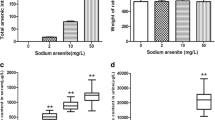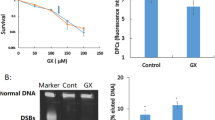Abstract
Chronic arsenic poisoning is reported to be associated with peripheral and cardiovascular disease, arteriosclerosis, Raynaud’s syndrome, hypertension, and Blackfoot disease. Monomethylarsonous acid (MMAIII) is a reactive metabolite of inorganic arsenic and a potent inhibitor of endothelial nitric oxide synthase (eNOS). Arsenic is also reported to phosphorylate eNOS in cultured keratinocyte and Human T cell leukemia Jurkat cells, respectively. In the present study, we examined the cytotoxicity and eNOS phosphorylation by MMAIII exposure in cultured bovine aortic endothelial cells (BAEC). Results showed that MMAIII is more toxic than arsenite in BAEC cells. The IC50 values for MMAIII and arsenite were determined to be approximately 1.7 and 24.1 μmol/L, respectively. Exposure of BAEC to MMAIII (0.75 μmol/L) caused a significant eNOS phosphorylation 15 min after MMAIII exposure. However, a complex of MMAIII with dithiothreitol (DTT) that lacks the reactivity with vicinal thiols unaffected eNOS phosphorylation. The present study shows that MMAIII generated during biomethylation of arsenic is highly toxic in BAEC. Our study also suggests that MMAIII could induce the eNOS phosphorylation through modification to cellular thiols of the eNOS enzyme. And the initial up-regulation of eNOS phosphorylation by MMAIII seems to be an adaptive response against disruption of eNOS bioactivity during arsenic exposure.

Similar content being viewed by others
References
Aposhian HV, Aposhian MM (2006) Arsenic toxicology: five questions. Chem Res Toxicol 19:1–15
Aposhian HV, Zakharyan RA, Avram MD, Sampayo-Reyes A, Wollenberg ML (2004) A review of the enzymology of arsenic metabolism and a new potential role of hydrogen peroxide in the detoxication of the trivalent arsenic species. Toxicol Appl Pharmacol 198:327–335
Cullen WR, McBride BC, Reglinski J (1984) The reaction of methylarsenicals with thiols: some biological implications. J Inorg Biochem 21:179–194
Engel RR, Hopenhayn-Rich C, Receveur O, Smith AH (1994) Vascular effects of chronic arsenic exposure: a review. Epidemiol Rev 16:184–209
Gomez LA, Alekseev AE, Aleksandrova LA, Brady PA, Terzic A (1997) Use of the MTT assay in adult ventricular cardiomyocytes to assess viability: effects of adenosine and potassium on cellular survival. J Mol Cell Cardiol 29:1255–1266
Hoffman RD, Lane MD (1992) Iodophenylarsine oxide and arsenical affinity chromatography: new probes for dithiol proteins. Application to tubulins and to components of the insulin receptor-glucose transporter signal transduction pathway J Biol Chem 267:14005–14011
Hossain K, Akhand AA, Kawamoto Y, Du J, Takeda K, Wu J, Yoshihara M, Tsuboi H, Kato M, Suzuki H, Nakashima I (2003) Caspase activation is accelerated by the inhibition of arsenite-induced, membrane rafts-dependent Akt activation. Free Rad Biol Med 34:598–606
Hughes MF (2002) Arsenic toxicity and potential mechanisms of action. Toxicol Lett 133:1–16
Kumagai Y, Pi J (2004) Molecular basis for arsenic-induced alteration in nitric oxide production and oxidative stress: implication of endothelial dysfunction. Toxicol Appl Pharmacol 198:450–457
Liu F, Jan KY (2000) DNA damage in arsenite- and cadmium-treated bovine aortic endothelial cells. Free Rad Biol Med 28:55–63
Petrick JS, Ayala-Fierro F, Cullen WR, Carter DE, Vasken Aposhian H (2000) Monomethylarsonous acid (MMA(III)) is more toxic than arsenite in Chang human hepatocytes. Toxicol Appl Pharmacol 163:203–207
Pi J, Kumagai Y, Sun G, Yamauchi H, Yoshida T, Iso H, Endo A, Yu L, Yuki K, Miyauchi T, Shimojo N (2000) Decreased serum concentrations of nitric oxide metabolites among Chinese in an endemic area of chronic arsenic poisoning in inner Mongolia. Free Rad Biol Med 28:1137–1142
Pi J, Horiguchi S, Sun Y, Nikaido M, Shimojo N, Hayashi T, Yamauchi H, Itoh K, Yamamoto M, Sun G, Waalkes MP, Kumagai Y (2003) A potential mechanism for the impairment of nitric oxide formation caused by prolonged oral exposure to arsenate in rabbits. Free Rad Biol Med 35:102–113
Sakurai T, Qu W, Sakurai MH, Waalkes MP (2002) A major human arsenic metabolite, dimethylarsinic acid, requires reduced glutathione to induce apoptosis. Chem Res Toxicol 15:629–637
Souza K, Maddock DA, Zhang Q, Chen J, Chiu C, Mehta S, Wan Y (2001) Arsenite activation of P13K/AKT cell survival pathway is mediated by p38 in cultured human keratinocytes. Mol Med 7:767–772
Styblo M, Del Razo LM, Vega L, Germolec DR, LeCluyse EL, Hamilton GA, Reed W, Wang C, Cullen WR, Thomas DJ (2000) Comparative toxicity of trivalent and pentavalent inorganic and methylated arsenicals in rat and human cells. Arch Toxicol 74:289–299
Sumi D, Taguchi K, Sun Y, Shinkai Y, Kumagai Y (2005) Monomethylarsonous acid inhibits endothelial nitric oxide synthase activity. J Health Sci 51:728–730
Acknowledgments
This study was supported by the National Natural Science Foundation of China (NSFC) research grant 30400362, 30530640 & 30600510, and also supported in part by the Japan-China Sasagawa Medical Fellowship. We are especially grateful to Dr. William R. Cullen for providing MMAIII.
Author information
Authors and Affiliations
Corresponding author
Rights and permissions
About this article
Cite this article
Li, B., Sun, Y., Sun, X. et al. Monomethylarsonous Acid Induced Cytotoxicity and Endothelial Nitric Oxide Synthase Phosphorylation in Endothelial Cells. Bull Environ Contam Toxicol 78, 455–458 (2007). https://doi.org/10.1007/s00128-007-9178-7
Received:
Accepted:
Published:
Issue Date:
DOI: https://doi.org/10.1007/s00128-007-9178-7




